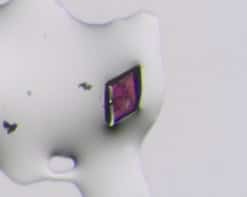
Toroidal electromagnetic pulses can be generated using a device known as a horn microwave antenna. This electromagnetic “vortex cannon” produces skyrmion topological structures that might be employed for information encoding or for probing the dynamics of light–matter interactions, according to its developers in China, Singapore and the UK.
Examples of toroidal or doughnut-like topology abound in physics – in objects such as Mobius strips and Klein bottles, for example. It is also seen in simpler structures like smoke rings in air and vortex rings in water, as well as in nuclear currents. Until now, however, no one had succeeded in directly generating this topology in electromagnetic waves.
A rotating electromagnetic wave structure
In the new work, a team led by Ren Wang from the University of Electronic Science and Technology of China, Yijie Shen from Nanyang Technological University in Singapore and colleagues from the University of Southampton in the UK employed wideband, radially polarized, conical coaxial horn antennas with an operating frequency range of 1.3–10 GHz. They used these antennas to create a rotating electromagnetic wave structure with a frequency in the microwave range.
The antenna comprises inner and outer metal conductors, with 3D-printed conical and flat-shaped dielectric supports at the bottom and top of the coaxial horn, respectively
“When the antenna emits, it generates an instantaneous voltage difference that forms the vortex rings,” explains Shen. “These rings are stable over time – even in environments with lots of disturbances – and maintain their shape and energy over long distances.”
Complex features such as skyrmions
The conical coaxial horn antenna generates an electromagnetic field in free space that rotates around the propagation direction of the wave structure. The researchers experimentally mapped the toroidal electromagnetic pulses at propagation distances of 5, 50 and 100 cm from the horn aperture, using a planar microwave anechoic chamber (a shielded room covered with electromagnetic absorbers) to measure the spatial electromagnetic fields of the antenna, using a scanning frame to move the antenna to the desired measurement area. They then connected a vector network analyser to the transmitting and receiving antennas to obtain the magnitude and phase characteristics of the electromagnetic field at different positions.
The researchers found that the toroidal pulses contained complex features such as skyrmions. These are made up of numerous electric field vectors and can be thought of as two-dimensional whirls (or “spin textures”). The pulses also evolved over time to more closely resemble canonical Hellwarth–Nouchi toroidal pulses. These structures, first theoretically identified by the two physicists they are named after, represent a radically different, non-transverse type of electromagnetic pulse with a toroidal topology. These pulses, which are propagating counterparts of localized toroidal dipole excitations in matter, exhibit unique electromagnetic wave properties, explain Shen and colleagues.
A wide range of applications
The researchers say that they got the idea for their new work by observing how smoke rings are generated from an air cannon. They decided to undertake the study because toroidal pulses in the microwave range have applications in a wide range of areas, including cell phone technology, telecommunications and global positioning. “Understanding both the propagation dynamics and characterizing the topological structure of these pulses is crucial for developing these applications,” says Shen.
The main difficulty faced in these experiments was generating the pulses in the microwave part of the electromagnetic spectrum. The researchers attempted to do this by adapting existing optical metasurface methodologies, but failed because a large metasurface aperture of several metres was required, which was simply too impractical to fabricate. They overcame the problem by making use of a microwave horn emitter that’s more straightforward to create.

Hopfions seen in a magnetic crystal
Looking forward, the researchers now plan to focus on two main areas. The first is to develop communication, sensing, detection and metrology systems based on toroidal pulses, aiming to overcome the limitations of existing wireless applications. Secondly, they hope to generate higher-order toroidal pulses, also known as supertoroidal pulses.
“These possess unique characteristics such as propagation invariance, longitudinal polarization, electromagnetic vortex streets (organized patterns of swirling vortices) and higher-order skyrmion topologies,” Shen tells Physics World. “The supertoroidal pulses have the potential to drive the development of ground-breaking applications across a range of fields, including defence systems or space exploration.”
The study is detailed in Applied Physics Reviews.



